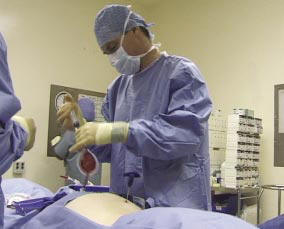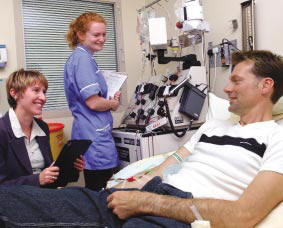So what happens if I'm a match?
This is the big question really.
The following information if reproduced from the Anthony Nolan Trust's
booklet "Commit to a Life Saving Procedure Now".
If You Are A Match
If your tissue type is found to be a
complete match (there may be occasions where you were found to
be a partial match), you offer immeasurable hope to that
patient, often at a time when desperation and fear are the
overriding emotions faced. Once identified as a tissue
matched compatible donor - and prior to the donation - you will
have a medical examination by an independent physician to
confirm your fitness to proceed. Further blood samples will be
taken to assess your health and ensure that no infection could
be passed from you to the patient. The Anthony Nolan Trust
not only helps patients in the UK, but also around the world.
All blood stem cell donations from Anthony Nolan volunteers,
however, take place at one of the specialised centres in London
and are hand carried by a personal courier to the patient's
transplant centre. The Anthony Nolan Trust makes all the
arrangements for the donor and covers any financial loss
incurred by our donors as a result of having donated blood stem
cells (subject to prior agreement). A family member or friend is
also able to accompany you to London. In compliance with
international agreement, strict anonymity is maintained between
donor and patient. After the donation you are at liberty
to decide whether to remain on the Register. There is no
reason on physical grounds why a healthy person should not
donate on more than one occasion.
Donation Options
Bone Marrow Extraction
Blood stem cells can be collected by
bone marrow extraction or taken from the peripheral blood.
Ideally all volunteers should be willing to donate by either
method. However, the final choice of donation method would be
yours, with guidance provided to help you reach the most
appropriate decision. Bone Marrow Donation Bone marrow donation
requires a two-night stay at a specialist hospital in London to
for a medical procedure called a harvest. Under general
anaesthetic, blood stem cells are extracted from the pelvic
bones by sterile needle and syringe. No surgical incision is
required, and the blood stem cells replace themselves within 21
days. You may feel some short-term post-operative tenderness and
discomfort in your lower back and tiredness is inevitable during
recovery. It is, therefore, advisable to plan to recuperate for
approximately one week before returning to work or other normal
duties. The most serious complication for the donor could be
reaction to the anaesthetic, but the risk is extremely low and
certainly no greater than undergoing any minor operation.
Peripheral Blood Stem Cell (PBSC)
Donation
Blood stem cells are also found in
the circulating blood stream (peripheral blood) as well as the
marrow, but in much smaller numbers. A growth factor known
as granulocyte-colony stimulating factor (G-CSF,which occurs
naturally in the body and regulates production of certain white
cells (neutrophils), is injected for five days prior to the
collection. This temporarily boosts neutrophil production
and encourages movement from the bone marrow where the cells are
made, out into the peripheral (circulating) blood.
The cells are then collected via a
sustained needle on a blood cell separator machine, in a process
known as apheresis. One or two collections on consecutive days,
each lasting approximately 4-5 hours may be required, but
overnight hospitalisation is not usually necessary and no
general anaesthetic. The effects of the G-CSF may include bone
pain and flu-like symptoms during the 5 day period the drug is
being administered but which resolve 1-2 days after the last
dose of the drug. During the collection the donor may experience
discomfort at the sites of the needle insertion and a temporary
tingling sensation in the body from the anticoagulant used to
keep the cells from clotting. No extended recuperation period
should, therefore, be necessary, although you are likely to feel
tired for a short time afterwards.